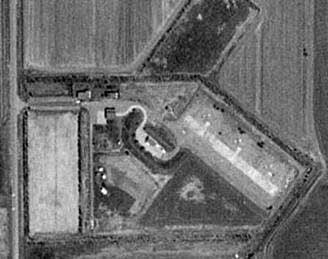 |
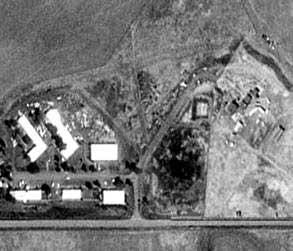 |
|
|
|
|
While undoubtedly known better as one of the US Air Force’s long-time trans-Pacific air terminals, Travis AFB initially saw most of its major operations as an installation of Strategic Air Command. Heading into the 1950s, the base – still known as Fairfield-Suisun AFB – became one of the focal points of SAC’s strategic reconnaissance force. By mid-decade the primary unit was the 5th Bombardment Wing, Heavy with three squadrons’ worth of the massive B-36 Peacemaker. As a result, Army Antiaircraft Command to put in an antiaircraft battalion to guard the base, the wing and an adjacent nuclear weapons storage depot.
The Travis defenses stood up with the activation of the 436th Anti-Aircraft Artillery Battalion at the base on 4 January 1955. I haven't determined the type weapon the 436th deployed at Travis, but the standard for SAC base defenses was the M51 75mm Skysweeper.
The 436th redesignated as an antiaircraft artillery missile battalion on 5 January 1957 and subsequently occupied four Nike Ajax sites, which went to 1st Missile Battalion, 61st Artillery on 1 September 1958. During this same period Army Air Defense Command (ARADCOM) stood up the 29th Artillery Group (Air Defense) at Travis, co-occupying the AN/GSG-5 BIRDIE-equipped Army Air Defense Command Post with the headquarters staff of the missile battalion. The group inactivated some time in 1962, leaving the 1/61st to operate the two surviving Nike Hercules sites at Fairfield and Elmira. The 116th Ordnance Detachment (Guided Missile Direct Support) provided ordnance support from the Nike Direct Support Facility at the Presidio, with satellite guided missile repair shops at Travis and the Navy Supply Depot at Alameda.
On 1 June 1971 Army Air Defense Command merged the Travis and San Francisco defenses and Headquarters & Headquarters Battery, 1st Battalion, 61st Air Defense Artillery moved to Fort Baker in Marin County where it replaced Headquarters & Headquarters Battery,1st Battalion, 51st Air Defense Artillery . Apparently the BIRDIE continued in operation at Travis although the primary AADCP for the combined defense shifted to the AN/TSQ-51 Missile Mentor-equipped SF-90DC at Mill Valley Air Force Station.
The surviving Travis Nike Hercules site, at Site T-10 in Elmira, continued in operation under the merged defense area through March 1974. The 1st Battalion, 61st Air Defense Artillery inactivated on 30 August 1974, concluding ARADCOM operations in the Bay Area and at Travis AFB.
Site T-10, Elmira – Both components are on Hay Road to the northwest of the base, west of Meridian Road and easy enough to find or stumble across. The battery site was locked up with no signs of occupancy but I could see the assembly building from the entrance on Lewis Road. If you turn left on Hay Road at the intersection with Lewis and drive east a bit you’ll see one very large, expensive house to the east of the launchers; rather exclusive development, eh?
 |
 |
|
|
|
|
The IFC is a 1.5 east on the north side of Hay Road; the HIPAR building is intact but overall the facility is very ratty with goats quietly feeding on the berms that apparently supported the other radars. The adjacent housing area is also in very poor shape and appears used by lower-income types.
T-10 was the primary fire control facility
of the two Travis sites which converted to Hercules, housing a
Secondary Master Fire Unit (SMFU; think of it as a BUIC system
for the local Army Air Defense Command Post) as well as the HIPAR.
The site had a 3B/12-launcher layout, converted from Ajax to Hercules
between June 1958 and January 1959 and held operations by A/436th
(/58-9/58), A/1/61st (9/58-3/74) and HHB 1/61st (/58-6/71). The
headquarters and headquarters battery shifted to Fort Baker in
June 1971 with ARADCOM’s merger of the Travis and San Francisco
Defense Areas (Visit date: 12 Mar 02)
Site T-33, Dixon/Lambie – This was the first operational
Ajax site in the Travis Defense and as such was a temporary set-up
with just enough concrete to anchor the rails and 12 launchers.
I stumbled across a photo of it somewhere along the line; the
only permanent components were the few foundations.
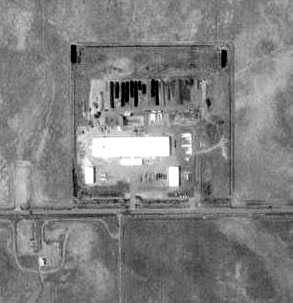 |
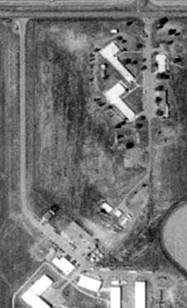 |
|
|
|
|
The Integrated Fire Control (IFC) area at Lambie Road and Goose Haven, is partially intact and serves as the Delta Conservation Camp, operated by the California Department of Forestry & Fire Protection and the California Department of Corrections. The street address is 6246 Lambie Road; the site is in excellent shape with some mods to the buildings.
The magazine/launcher facility is at Lambie Road and Rithell about a mile to the north-northwest and is completely gone and in agricultural use with only a couple of berms remaining. The California State Department of Health Services has several buildings alongside; D/436th (5/58-9/58), D/1/61st (9/58-1/59) manned the site.
Site T-53, Potrero Hills - Both components are southwest of Travis on Explosives Technology Road; when I was here last in December 1988 Explosive Technologies owned and operated the facility and the president himself gave me a quick tour.
However, since then a company named OEA acquired the operation and continued using it for the storage and manufacturing of airbag initiators and canopy shattering systems (in some aircraft you have to blow the canopy glass before ejecting through the frame). Autoliv, a Swedish company, acquired OEA in 2000; it listed the latter as “the world’s second largest manufacturer of airbag initiators with production last year of 32 million such ignitors. In addition, OEA manufactures inflators for airbags and aerospace products.” OEA’s headquarters were in Denver; it had other facilities in Colorado, Utah and France.
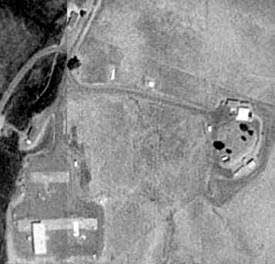 |
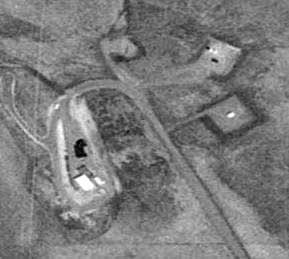 |
|
|
|
|
So what did I find at the top of the drive? Intact buildings by
the gate and a big “Goodrich Aerospace” sign. The guard
said Goodrich bought out the operation some time ago; seeing as
it was pushing five and there was a steady stream of workers pouring
out I decided against requesting a quick visit.
Site T-53 was the only Travis site to have both components in the same general area; the IFC was at the top of the hill to the west of the battery area. You can see the remains of the IFC – a couple of buildings and some plats – as you drive into the facility. According to the guard one of the magazines still has a building over the elevator but the other two elevators are now inoperative. The site was of 1B2C/12-launcher configuration, operated by B/436th (/58-9/58) and B/1/61st (9/58-1/59).
Site T-86 Fairfield/Cement Hills – This one is undoubtedly the easiest of the four to get to as the launcher facility is on the north side of Air Base Parkway heading into Travis. It was 1B2C/12L installation with two magazines/eight launchers modified for Hercules between December 1960 and June 1961. The operating units were C/436th (/58-9/58) and C/1/61st (9/58-6/71) and the site had an AN/FPS-75 as an ABAR.
As mentioned the road to the top of the hill is still gated; I prowled around a bit on the fringes of yet another new housing development (typically California crammed-in) and still couldn't find access to the top so I moved south a mile to the intersection of Clay Bank Road and Air Base Parkway and found a way into the compound. The old administrative area – hard by the parkway – is very decrepit now and unoccupied; there were several large dumpsters scattered about full of particle board and the like. To the immediate northeast are the Solano County Detention Center and the Solano County Department of Education/Golden Hills Education Center.
 |
 |
|
|
|
|
The magazines are to the north, now used by the Fairfield-Suisun
Unified School District for school bus maintenance and parking.
They put the buses right on top of the magazines/launchers; the
assembly building is in place – modified by an add-on –
and the fueling area is still in the right spot but all of the
berms were leveled (12 Mar 02).